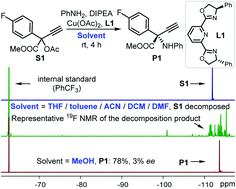Practical asymmetric amine nucleophilic approach for the modular construction of protected α-quaternary amino acids†
Abstract
We report the first amine nucleophilic approach for the modular construction of enantioenriched protected α-quaternary amino acids. The key to success is the use of an alcohol solvent, which makes a rationally designed COOMe-bonded Cu-allenylidene electrophilic intermediate stable enough to couple with amine nucleophiles before its decomposition. The reaction features wide functional group tolerance with high enantioselectivity, typically >90% ee, and is amenable to the modification of commercially available bioactive molecules. The resultant protected α-amino acids could be readily converted into a number of precious enantioenriched amines featuring α-hindered tertiary carbon centers, which are otherwise synthetically quite challenging, including those of α-amino aldehyde, peptides or α-vinyl amino ester with >92% ee in excellent yields. This protocol could be utilized for the synthesis of the protected bioactive α-ethylnorvaline in 3 steps, a significant advancement in comparison to an 11-step sequence reported previously.

- This article is part of the themed collection: In celebration of Chinese New Year


 Please wait while we load your content...
Please wait while we load your content...